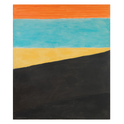It’s tempting to think of memes as a uniquely modern thing, aided and abetted by the language of the internet. Though the term was initially coined by Richard Dawkins in 1976 to describe an idea that becomes shared within a culture, online, it has taken on a slightly different life. Memes on Twitter and Tumblr retain this virality, but also have a uniquely absurdist comedic nature.
Google’s dictionary now lists two definitions: “1. An element of culture or system of behaviour passed from one individual to another by imitation or other non-genetic means” and “2. An image, video, piece of text, etc., typically humorous in nature, that is copied and spread rapidly by Internet users, often with slight variations.”
Sometimes these internet memes have cloudy origin points, though the website Know Your Meme is impressively thorough in tracking them down. Occasionally, however, the opposite is true—occasionally, with the benefit of hindsight, it feels like something was destined to become a meme from its very genesis. This is true in the case of William Carlos Williams’ 1932 imagist poem “This Is Just To Say.”
https://twitter.com/meganlavengood/status/935319773910568960
Over the past few weeks, the poem has become the meme-du-jour on Twitter, after initially coming on the scene a few years ago. More recently, buoyed by an increased character limit, the meme has developed from people simply aping the form of the poem to remixing it.
Users are pulling out the poem's most recognisable symbols—the plums; the icebox—and splicing them with other poems, other cultural references, other memes, while still making it apparent what they're referring to.
https://twitter.com/thwphipps/status/935465303202557952
The meme life of “This Is Just To Say” did not begin online. If we take a meme to mean an idea, or piece of culture, that is then shared or reappropriated, then “This Is Just To Say” fits that description from the off.
As Williams himself revealed in a 1950 interview with John W. Gerber, the poem was originally just a note he left for his wife: “It’s curious how a thing of this sort, which was really just a passing gesture, actually took place just as it says here,” he said.
Kristen Treen, a Teaching Fellow in American Literature at UCL, argues that it is exactly this status as a piece of ‘found art’ which allows it to become ripe for parody: “The ‘foundness’ of the poem’s content, and the particular way the arrangement of lines delivers us that unexpected ‘found’ experience, transport us between the sublime and the ridiculous.”
Incidentally, the other most memed work of literature springs from a similar ‘found’ style: the famous “baby shoes” snippet attributed to Ernest Hemingway.
https://twitter.com/jennyharicot/status/935993197364379650
So maybe we should consider the online memefication of “This Is Just To Say” as an extension of its history of parody. In an episode of This American Life back in 2008, reporter and poet Sean Cole explains that imitation or spoofing of “This Is Just To Say” has long been a game among poets. Take, for instance, Kenneth Koch’s 1962 poem“Variations on a Theme by William Carlos Williams”, four separate apologetic verses that speak in similar crisp reverence for unconnected, everyday things, but turn them into something deliberately funny:
2
We laughed at the hollyhocks together and then I sprayed them with lye. Forgive me. I simply do not know what I am doing. So, it’s a joke, and as we know, jokes naturally lead to virality—they encourage a kind of turn-taking among people, and provide a loose framework that can be amended in any number of ways.
Even before Koch decided to get the balling rolling, the fact that Williams has inflated a passing exchange to the status of an Imagist Poem, leaving it open to the lofty interpretations of Serious Academics—a cursory search of scholarship on the poem brings up everything from temptation to Oedipus—is in itself pretty funny. (Treen argues that Koch’s parody is absolutely a send up of the kind of serious statements one might read into the original text.)
In that Gerber interview, when confronted with the question of what makes it a poem at all, it’s mentioned that Williams is laughing. His initial response is kind of cheekily obstinate: “it’s metrically absolutely regular...dogmatically speaking, it has to be a poem because it goes that way, don’t you see!” In other words: “it’s a poem because I say so, ha!”
However, there is still a way to go between this and Twitter. People have spoken about how the brevity of the poem is what has contributed to its memefication, but people haven’t done the same thing with other imagist poems. Nobody’s spoofing Ezra Pound’s “In A Station Of The Metro.”
https://twitter.com/j4/status/936697985202905089
While it’s undeniable that there are formal similarities between the central tenets of imagism and the way in which people communicate on Twitter, in terms of clarity and succinctness of expression, there is a kind of randomness to “This Is Just To Say” that ties in with a lot of the kind of humour that has become popular since the turn of the millennium—things like Family Guy or The Mighty Boosh, where the jokes derive from a clash of images, references, or other nonsensical situations, rather than anything more formal.
Treen notes that the transgression present in “This Is Just To Say,” the brazen theft of sweet plums, shares that randomness: “while the syllable count / irregular metrical scheme of Williams's poem makes it easy to fit whatever we like into his framework, it's that cheeky revelation through the line-breaks that, when we parody him, gives our day-to-day that sense of foundness or randomness that, culturally, we seem to quite enjoy right now.”
https://twitter.com/incogellen/status/936007928691281920
It feels as if the use of that term—“randomness”—does tally nicely with the rise of millennials. Clunky and crass though it is, Urban Dictionary has an entry for the word “random” as far back as 2005. Before that, in a 2003 article in the Washington Post, Ken Ringle notes that the preoccupation with “randomness” is very much the antithesis of the slang-term of choice in the Baby Boomer era, “neat”: “the achievement (or at least appearance) of order and symmetry in one’s personal life equivalent to the butch haircuts, trimmed lawns and squared corners evanescent in 1950s public life. No loose ends left dangling.”
It’s fair to say that order and symmetry are very much not what characterise being a young person growing up post-2000. Ben Zimmer, former language columnist for theNew York Times, writes: “Young people are growing up in a world that accepts a kind of random clashing of ideas and concepts.”
“Things like online culture certainly encourage the mixing of disparate elements that would normally not go together. Even just the experience of browsing the web is an experience where there can be a tenuous relation from one stop to the next.”
https://twitter.com/kinson_k/status/936472631972376576
At the risk of sounding like I’m ascribing too much intellectual value to what are essentially jokes, it feels as if we are growing a kind of meme canon. If you consider other Big Memes—the four eels tweet, the ‘teeth teeth teeth’ tweet, the Dril candles tweet—or even the kinds of pop cultural icons that become parodied—Guy Fieri, Joe Biden, children’s TV program Arthur—there’s no through line here, nothing that links one to the other, and certainly nothing obvious that links anything here to William Carlos Williams. But they all add to the growing language of online communication. We are building our own versions of knock-knock jokes.
Really, to try and pin down the rules that make something able to be meme’d is like chasing your own tail. To paraphrase Williams himself: they have to become memes because they go that way, don’t you see!












